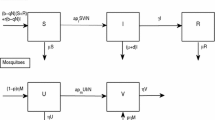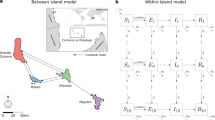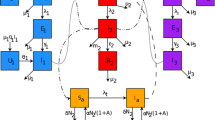Abstract
Rift Valley fever (RVF) is a severe viral zoonosis in Africa and the Middle East that harms both human health and livestock production. It is believed that RVF in Egypt has been repeatedly introduced by the importation of infected animals from Sudan. In this paper, we propose a three-patch model for the process by which animals enter Egypt from Sudan, are moved up the Nile, and then consumed at population centers. The basic reproduction number for each patch is introduced and then the threshold dynamics of the model are established. We simulate an interesting scenario showing a possible explanation of the observed phenomenon of the geographic spread of RVF in Egypt.



Similar content being viewed by others
References
Abd el-Rahim, I. H., Abd el-Hakim, U., & Hussein, M. (1999). An epizootic of Rift Valley fever in Egypt in 1997. Rev. Sci. Tech., 18, 741–748.
Abdo-Salem, S., Tran, A., Grosbois, V., Gerbier, G., Al-Qadasi, M., Saeed, K., Etter, E., Thiry, E., Roger, F., & Chevalier, V. (2011a). Can environmental and socioeconomic factors explain the recent emergence of Rift Valley fever in Yemen, 2000–2001? Vector-Borne Zoonotic Dis., 11, 773–779.
Abdo-Salem, S., Waret-Szkuta, A., Roger, F., Olive, M., Saeed, K., & Chevalier, V. (2011b). Risk assessment of the introduction of Rift Valley fever from the Horn of Africa to Yemen via legal trade of small ruminants. Trop. Anim. Health Prod., 43, 471–480.
Anyamba, A., Chretien, J.-P., Small, J., Tucker, C. J., Formenty, P. B., Richardson, J. H., Britch, S. C., Schnabel, D. C., Erickson, R. L., & Linthicum, K. J. (2009). Prediction of a Rift Valley fever outbreak. Proc. Natl. Acad. Sci. USA, 106, 955–959.
Chamchod, F., Cantrell, R. S., Cosner, C., Hassan, A., Beier, J. C., & Ruan, S. (2012, submitted). A modeling approach to investigate epizootic outbreaks and enzootic maintenance of Rift Valley fever virus.
Chitnis, N., Hyman, J. M., & Cushing, J. M. (2008). Determining important parameters in the spread of malaria through the sensitivity analysis of a mathematical model. Bull. Math. Biol., 70, 1272–1296.
Daubney, R., Hudson, J. R., & Granham, P. C. (1931). Enzootic hepatitis or Rift Valley fever: an undescribed virus disease of sheep cattle and man from East Africa. J. Pathol. Bacteriol., 34, 545–579.
Favier, C., Chalvet-Monfray, K., Sabatier, P., Lancelot, R., Fontenille, D., & Dubois, M. A. (2006). Rift Valley fever in West Africa: the role of space in endemicity. Trop. Med. Int. Health, 11, 1878–1888.
Gad, A. M., Feinsod, F. M., Allam, I. H., Eisa, M., Hassan, A. N., Soliman, B. A., el Said, S., & Saah, A. J. (1986). A possible route for the introduction of Rift Valley fever virus into Egypt during 1977. J. Trop. Med. Hyg., 89, 233–236.
Gaff, H. D., Hartley, D. M., & Leahy, N. P. (2007). An epidemiological model of Rift Valley Fever. Electron. J. Differ. Equ., 115, 1–12.
Gao, D., & Ruan, S. (2011). An SIS patch model with variable transmission coefficients. Math. Biosci., 232, 110–115.
Hoogstraal, H., Meegan, J. M., Khalil, G. M., & Adham, F. K. (1979). The Rift Valley fever epizootic in Egypt 1977–78. II. Ecological and entomological studies. Trans. R. Soc. Trop. Med. Hyg., 73, 624–629.
Ikegami, T., & Makinob, S. (2009). Rift Valley fever vaccines. Vaccine, 27, D69–D72.
Kamal, S. A. (2011). Observations on Rift Valley fever virus and vaccines in Egypt. Virol. J., 8, 532.
LaSalle, J. P. (1976). The stability of dynamical systems. Philadelphia: SIAM.
Li, M. Y., & Muldowney, J. S. (1996). A geometric approach to global-stability problems. SIAM J. Math. Anal., 27, 1070–1083.
Linthicum, K. J., Anyamba, A., Tucker, C. J., Kelley, P. W., Myers, M. F., & Peters, C. J. (1999). Climate and satellite indicators to forecast Rift Valley fever epidemics in Kenya. Science, 285, 397–400.
Meegan, J. M. (1979). The Rift Valley fever epizootic in Egypt 1977–78: 1. Description of the epizootic and virological studies. Trans. R. Soc. Trop. Med. Hyg., 73, 618–623.
Meegan, J. M., Khalil, G. M., Hoogstraal, H., & Adham, F. K. (1980). Experimental transmission and field isolation studies implicating Culex pipiens as a vector of Rift Valley fever virus in Egypt. Am. J. Trop. Med. Hyg., 29, 1405–1410.
Métras, R., Collins, L. M., White, R. G., Alonso, S., Chevalier, V., Thuranira-McKeever, C., & Pfeiffer, D. U. (2011). Rift Valley fever epidemiology, surveillance, and control: what have models contributed? Vector-Borne Zoonotic Dis., 11, 761–771.
Mpeshe, S. C., Haario, H., & Tchuenche, J. M. (2011). A mathematical model of Rift Valley fever with human host. Acta Biotheor., 59, 231–250.
Paweska, J. T., Mortimer, E., Leman, P. A., & Swanepoel, R. (2005). An inhibition enzyme-linked immunosorbent assay for the detection of antibody to Rift Valley fever virus in humans, domestic and wild ruminants. J. Virol. Methods, 127, 10–18.
Smith, H. L., & Waltman, P. (1995). The theory of the chemostat. Cambridge: Cambridge University Press.
Thieme, H. R. (1993). Persistence under relaxed point-dissipativity (with application to an endemic model). SIAM J. Math. Anal., 24, 407–435.
van den Driessche, P., & Watmough, J. (2002). Reproduction numbers and sub-threshold endemic equilibria for compartmental models of disease transmission. Math. Biosci., 180, 29–48.
World Health Organization (2010). Rift Valley fever, fact sheet no. 207. http://www.who.int/mediacentre/factsheets/fs207/en/.
Xue, L., Scott, H. M., Cohnstaedt, L. W., & Scoglio, C. (2012). A network-based meta-population approach to model Rift Valley fever epidemics. J. Theor. Biol., 306, 129–144.
Yang, H., Wei, H., & Li, X. (2010). Global stability of an epidemic model for vector-borne disease. J. Syst. Sci. Complex., 23, 279–292.
Acknowledgement
We thank two anonymous referees for their valuable comments and suggestions which led to an improvement of our original manuscript. Research was supported by the National Institute of Health (NIH) grant R01GM093345.
Author information
Authors and Affiliations
Corresponding author
Rights and permissions
About this article
Cite this article
Gao, D., Cosner, C., Cantrell, R.S. et al. Modeling the Spatial Spread of Rift Valley Fever in Egypt. Bull Math Biol 75, 523–542 (2013). https://doi.org/10.1007/s11538-013-9818-5
Received:
Accepted:
Published:
Issue Date:
DOI: https://doi.org/10.1007/s11538-013-9818-5




